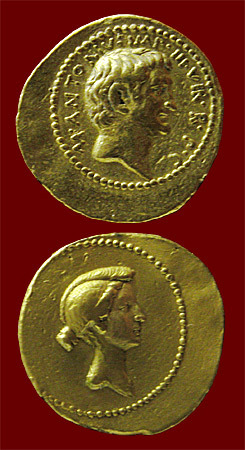ancientcoins:myancientworld:Coin of Mark Antony and Octavia Aureus.The inscriptions which are on the
ancientcoins:myancientworld:Coin of Mark Antony and Octavia Aureus.The inscriptions which are on the side of Mark Antony, reads: “M(arcus) ANTONIVS IMP(erator) IIIVIR R(ei) P(ublicae) C(onstituendae). The reverse side of the coin features the portrait of his wife Octavia, who was the sister of Octavian (he later became Augustus). Octavia wears her characteristic nodus hairstyle which she was often depicted with.Having recently done a fair bit of reading recently about the portico of Octavia and about Julio-Claudian women in general, I thought we might return to this Aureus and talk a little about the use of women on imperial coinage. Octavia is the first living woman to appear on a Roman coin, but Mark Antony’s third wife, Fulvia, also appears on coins after her death and is believed to be the first woman to have her portrait on a Roman coin. A living woman would not appear named on a coin until the reign of Gaius (Caligula), who names his sisters on his coinage and who creates the first diva, deified woman of the imperial family, following the death of his sister Drusilla. The coincidence here that Octavia is shown as Mark Antony’s wife and as sister to Octavian, and thus the link between the two triumvirs suggests that Roman women, and Octavia in particular, were recognized as an important source of political power. Antony in particular seems to have liked showing his wives on coins, since Cleopatra after this also appears on coins following their marriage.Octavia came to represent something of a martyr and living embodiment of the dream of the perfect Roman mother. Abandoned by Antony who preferred Cleopatra, either for romantic or political reasons, Octavia remained in Rome where she raised her children from her first marriage, her two daughters by Antony, and Antony’s children from his previous marriages. To the veritable day-care she was running were added the children of Antony and Cleopatra after they were defeated and committed suicide.Octavia lived to be 58 and appears to have died of natural causes. During her life she donated the Portico of Octavia, a large open-air structure that surrounded two older temples, included two new libraries, and housed an extensive art collection. She never remarried after Antony and stopped appearing on coins following her marriage. -- source link
